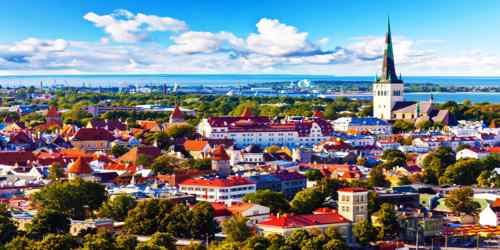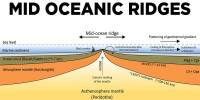Tallinn (/ˈtɑːlɪn, ˈtælɪn/; Estonian: (ˈtɑlʲˑinˑ); names in other languages) is the capital city of Estonia. The city of Tallinn is a vibrant and exciting city that is attracting more and more visitors. It’s is a compact city that’s easy to walk around. Just get lost in the cute streets of the old town and take a rest to enjoy the hustle and bustle of the town square. Located in the northern part of the country, on the shore of the Gulf of Finland of the Baltic Sea, it has a population of 437,619 in 2020. Administratively a part of Harju maakond (county), Tallinn is the main financial, industrial, cultural, educational, and research center of Estonia. Tallinn is located 80 kilometers (50 mi) south of Helsinki, Finland, 320 kilometers (200 mi) west of Saint Petersburg, Russia, 300 kilometers (190 mi) north of Riga, Latvia, and 380 kilometers (240 mi) east of Stockholm, Sweden. It has close historical ties with these four cities. From the 13th century until the first half of the 20th century Tallinn was known in most of the world by its historical German name Reval.
No longer the plaything of greater powers – Danish, Swedish, Polish, German, and Soviet; Tallinn is now a proud European capital with an allure all of its own. It’s lively yet peaceful, absurdly photogenic, and bursting with wonderful sights ancient churches, medieval streetscapes, and noble merchants’ houses. Throw in delightful food and vibrant modern culture and it’s no wonder Tallinn seems in danger of being loved to death, especially after a few cruise ships dock. But it’s one of those blessed places that seems to cope with all the attention.
Head up to Toompea Hill and check out the Parliament Building, St. Alexander Nevsky Cathedral, and the artillery tower Kiek in de Kök. While visitors are in the old town, seek out the cute St. Catherine’s Passage and shop for authentic local souvenirs. Then make sure to pause in Freedom Square and remember how recently this country gained its independence.

Tallinn, first mentioned in 1219, received city rights in 1248, but the earliest human settlements date back 5,000 years. The first recorded claim over the land was laid by Denmark in 1219, after a successful raid of Lyndanisse led by King Valdemar II, followed by a period of alternating Scandinavian and Teutonic rulers. Due to its strategic location, the city became a major trade hub, especially from the 14th to the 16th century, when it grew in importance as part of the Hanseatic League. Tallinn’s Old Town is one of the best-preserved medieval cities in Europe and is listed as a UNESCO World Heritage Site.
Tallinn has the highest number of start-ups per person among European countries and is the birthplace of many international high technology companies, including Skype and Transferwise. The city is to house the headquarters of the European Union’s IT agency. Providing to the global cybersecurity it is the home to the NATO Cyber Defence Centre of Excellence. Tallinn is ranked as a global city and has been listed among the top ten digital cities in the world. The city was a European Capital of Culture for 2011, along with Turku in Finland. The population of Tallinn on 1st January 2020 was 437,619.
History of the city –
It is not easy to determine the beginning of Tallinn’s history. The location probably attracted attention as a suitable port area long before first written sources mention a settlement there, but all historians have is archaeological data.
The first traces of settlement in the territory of today’s Tallinn come from the Härjapea river basin at Keldrimäe but those cannot be directly linked to the city. The early history of Tallinn begins from suburban Iru, where a castle together with a nearby settlement was built in the end of the first millennium. The castle was abandoned for unknown reasons in the end of the 11th century and Lindanise (Kolyvan in Russian sources) castle was built sometime later on today’s Toompea hill this was basically the center of the ancient Rävala county (hence the German name for Tallinn: Reval). The castle was most probably only to offer refuge in case of enemy attacks and included no permanent settlement in the 13th century.
The trade route in the Gulf of Finland became more widely used during the 9th and 10th centuries and thereby increased the importance of the Tallinn port site. There might have been seasonal settlements of Scandinavian and Russian merchants at the location of today’s lower town in the beginning of the 2nd millennium but there is no clear evidence neither form archaeological nor written sources.
The first traces of human settlement found in Tallinn’s city center by archeologists are about 5,000 years old. The comb ceramic pottery found on the site dates to about 3000 BCE and corded ware pottery c. 2500 BCE.
Around 1050, the first fortress was built on Tallinn Toompea. As an important port for trade between Russia and Scandinavia, it became a target for the expansion of the Teutonic Knights and the Kingdom of Denmark during the period of Northern Crusades in the beginning of the 13th century when Christianity was forcibly imposed on the local population. Danish rule of Tallinn and Northern Estonia started in 1219.
From 1227 to 1238 Tallinn and Northern Estonia were governed by the Order of the Brotherhood of the Swords who had temporarily gained power from the Danes. There must have already been a small settlement at the bottom of the castle at that time. Around 1230 German merchants invited by the Brotherhood of the Swords arrived to Tallinn from Gothland. This arrival is considered an important event in the making of the body of residents in Tallinn. Tallinn together with the Northern part of Estonia was returned to the Danish crown by the Stensby Treaty, the deal being mediated by the legate of Pope Guillelmus of Modena. Ten years later, on 15th May 1248, King of Denmark Erik IV Adraraha gave Tallinn the Lübeck Rights that bound Tallinn to common legal space with medieval German merchant towns. The letter of rights also mentions representatives of Town Council which proves that the lower town must have had some kind of a local government at that time. Tallinn joined the Hanseatic League at the end of the 13th century, and during the next couple of hundred years performed an important role in relations of the Hanseates with the merchants of Russia, especially Novgorod.
In 1285, Tallinn, then known more widely as Reval, became the northernmost member of the Hanseatic League a mercantile and military alliance of German-dominated cities in Northern Europe. The king of Denmark sold Reval along with other land possessions in northern Estonia to the Teutonic Knights in 1346. Medieval Reval enjoyed a strategic position at the crossroads of trade between Western and Northern Europe and Russia. The city, with a population of about 8,000, was very well fortified with city walls and 66 defense towers.
In the end of the middle ages, town residency was restricted for Estonians, mainly because of the high resident fee. As the town needed working hands, then country folks migrated to town which in turn lead to conflicts between landowners in town and of the nearby areas. The number of inhabitants grew as trade grew and the town developed. As the estimated number of inhabitants in Tallinn in the middle of the 14th century was less than 1000 people, then in the late middle ages the population of Tallinn was already 6000-7000.
Buildings-wise, the town of the 13th century cannot be compared to the town in the late middle ages. The initial fortifications only comprised a small area around today’s Town Hall Square. The zone at that time did not include either the Dominican Convent between today’s Vene and Müürivahe Streets or the Cisterian Convent near today’s Kloostri Street. The town wall circle in its later form was established in the 14th century and the major boom of town construction (that gave the main buildings their medieval exteriors that are partly preserved even today) spread in Tallinn only in the 15th century. The New Town Hall was completed in 1404, the Great Guild building in 1410, and the Olavi Guild building in 1422. The Great Fire burst out in the lower town in 1433, and this meant a new wave of construction. The establishment of hill fortifications in front of the town wall was begun in the 16th century.
In 1561, Reval became a dominion of Sweden. During the Great Northern War, plague-stricken Tallinn along with Swedish Estonia and Livonia capitulated to Imperial Russia in 1710, but the local self-government institutions (Magistracy of Reval and Chivalry of Estonia) retained their cultural and economical autonomy within Imperial Russia as the Governorate of Estonia. The Magistracy of Reval was abolished in 1889. The 19th century brought industrialization of the city and the port kept its importance. During the last decades of the century Russification measures became stronger. Off the coast of Reval, in June 1908, Tsar Nicholas II and Tsarina Alexandra of Russia, along with their children, met their mutual uncle and aunt, Britain’s King Edward VII and Queen Alexandra, an act which was seen as a royal confirmation of the Anglo-Russian Entente of the previous year, and which was the first time a reigning British monarch had visited Russia.
The valuation of Estonian ethnicity started in the turn of the 19th and 20th centuries. The level of education and the economic standing of Estonians had improved. Estonian literates participated in the fight for local power mainly with the help of the newspaper “Teataja”. The 1904 elections were won by an Estonian-Russian block of 5 Russians and 38 Estonians. The first Estonian mayor Voldemar Lender was elected in 1906. Several changes took place in governing of Tallinn in the end of WW I. In 1917 the city council and city government elected in accordance with the Temporary Government town laws were in power for a short period and were in essence Bolshevist. The city council was dismissed by the Tallinn Workers and Military Deputies Soviet resolution of January 31, 1918, and the Soviet assumed the functions of the council. On February 24, 1918, Estonia took advantage of the weakening Bolsheviks and proclaimed independence; already the next day German troops occupied Estonia.
Local town government was restored after Germany capitulated in the WW I. The first city council elected during the Republic of Estonia assembled on June 16, 1919.
As said before, the Tallinn population began to grow hand in hand with the development of industry in the 2nd half of the 19th century. If in 1881 Tallinn had almost 44 000 inhabitants, then in 1917 the population was almost 160 000. The population decreased by about a third due to the WW I and the events concurring with it. There were 145 000 inhabitants in Tallinn in 1939.
Compared to the industrial boom prior to WW I caused by mainly the increase of military industry and the large Russian market, the industrial output of Tallinn decreased considerably after Estonia’s independence, and grew only by the end of the 1930-s.
During World War II, Estonia was first occupied by the Red Army and annexed into the USSR in 1940, then occupied by Nazi Germany from 1941 to 1944. When German forces invaded there were about 1,000 remaining Jews in the city of Tallinn, nearly all of whom would die in the Holocaust at the hands of the Nazis before the war’s end. After the German retreat in 1944, the city was occupied again by the Soviets. After the annexation of Estonia into the USSR, Tallinn became formally “the capital city” of the Estonian SSR within the Soviet Union.
During the 1980 Summer Olympics, the sailing (then known as yachting) events were held at Pirita, north-east of central Tallinn. Many buildings, such as the Tallinn TV Tower, “Olümpia” hotel, the new Main Post Office building, and the Regatta Centre, were built for the Olympics.
In 1991, an independent democratic Estonian nation was reestablished and a period of quick development as a modern European capital ensued. Tallinn became the capital of a de facto independent country once again on 20th August 1991.
Estonia regaining its independence brought upon significant changes in most of the important sectors of city life. Tallinn became the capital of the newly independent Republic of Estonia. The population of Tallinn decreased during the first years of independence, mostly due to non-Estonians leaving. If the population of Tallinn in the end of the 1980-s was c 480 000, then in 1995 it was only 434 800.
Some of the Soviet times industrial enterprises have reorganized and continued to operate, at a lesser volume, as private companies also after Estonia regained independence. New secondary schools and universities have emerged, especially private schools of law and economics.

Geography, Geology, and Culture –
Tallinn is situated on the southern coast of the Gulf of Finland, in north-western Estonia. The largest lake in Tallinn is Lake Ülemiste (9.44 km2 (3.6 sq mi)). It is the main source of the city’s drinking water. Lake Harku is the second largest lake within the borders of Tallinn and its area is 1.6 square kilometers (0.6 sq mi). Tallinn does not lie on a major river. The only significant river in Tallinn is Pirita River in Pirita, a city district counted as a suburb. Historically, the small Härjapea River flowed from Lake Ülemiste through the town into the sea, but the river was diverted for sewage in the 1930s and has since completely disappeared from the cityscape. References to it still remain in the street names Jõe (from Jõgi, river) and Kivisilla (from Kivisild, stone bridge).
Tallinn has a humid continental climate (Köppen climate classification Dfb) with warm, mild summers and cold, snowy winters. Winters are cold but mild for its latitude, owing to its coastal location. The average temperature in February, the coldest month, is −4.3 °C (24.3 °F). During the winter months, temperatures tend to hover close to the freezing mark but mild spells of weather can push temperatures above 0 °C (32 °F), occasionally reaching above 5 °C (41 °F) while cold air masses can push temperatures below −18 °C (0 °F) an average of 6 days a year. Snowfall is common during the winter months. Winters are cloudy and are characterized by low amounts of sunshine, ranging from only 0.5 hours of sunshine per day in December to 4.1 hours in March. At the winter solstice daylight lasts for only 6 hours.
A limestone cliff runs through the city. It can be seen at Toompea, Lasnamäe, and Astangu. However, Toompea is not a part of the cliff, but a separate hill. The highest point in Tallinn, at 64 meters above sea level, is situated in Hiiu, Nõmme District, in the south-west of the city.
The city’s historic center was designated a UNESCO World Heritage site in 1997. Today Tallinn is a major commercial and fishing port and industrial center. Shipbuilding and machine-building head a range of engineering industries, and many consumer goods are produced. The cultural center of Estonia, Tallinn has an academy of sciences; polytechnic, fine-arts, and teacher-training institutes; a music conservatory; and several theatres and museums. Tallinn Airport, servicing both domestic and international flights, is the biggest airport in the Baltics.
Economy and Tourism –
Tallinn is the financial and business capital of Estonia. The city has a highly diversified economy with particular strengths in information technology, tourism, and logistics. Over half of the Estonian GDP is created in Tallinn. In 2008, the GDP per capita of Tallinn stood at 172% of the Estonian average.
Once home to wealthy merchants settling from Germany, Denmark, and beyond, Tallinn Old Town today is enjoyed by locals and visitors alike, with restaurants, bars, museums, and galleries bringing much life to this historical city center.
Tallinn receives 4.3 million visitors annually, a figure that has grown steadily over the past decade. Tallinn’s Old Town, a UNESCO World Heritage Site, is a major tourist attraction; others include the Seaplane Harbour of Estonian Maritime Museum, the Tallinn Zoo, Kadriorg Park, and the Estonian Open Air Museum. The mysterious passages in Tallinn’s earthwork fortifications were built along with the bastions in the 17th and 18th centuries in order to conceal the movement of soldiers, ammunition, and other equipment from the enemy. They were also used to monitor the enemy’s underground mining activities. Most of the visitors come from Europe, though Tallinn has also become increasingly visited by tourists from Russia and the Asia-Pacific region.
Kumu, which opened in 2006, is the new and grand headquarters of the Art Museum of Estonia, which attracts everyone that is interested in Estonian art and culture. Both Estonian art classics as well as the works of artists that cultivate modern trends are on display at Estonia’s largest museum. In 2008, the Kumu Art Museum was recognized as the best museum in Europe and the winner of the European Museum of the Year Award.
Information Sources:
















